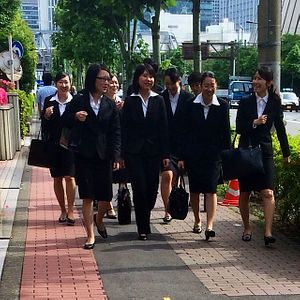While there has been much talk about the significant disparities in male and female wages in Japan, South Korea has its own gender gap. In fact, the 2013 Global Gender Gap Report, which measures the gap between genders in economic, political, education, and health-based criteria, ranked South Korea 111, below Japan at 105, and lower than South Korea’s rank in 2006 of 92. The report suggests that countries, despite their impressive economic status, have a long way to go to achieve gender equality.
South Korea’s first female president, Park Geun-hye, promised in her campaign to address women’s issues, such as improving childcare. Prime Minister Shinzo Abe has also declared that he intends to boost the female employment rate in Japan, while empowering women in the workforce. For example, he has proposed to have women occupy 30 percent of leadership positions by 2020.
The working cultures of Japan and South Korea are quite similar, including long hours and the traditional socializing after work, which is an unpaid but almost compulsory part of the job used to build contacts and talk business with coworkers. Both countries also have a rapidly aging population, which makes childcare a crucial societal role for maintaining the strength of the workforce.
Also similar to Japan, women in South Korea face obstacles after they give birth. Although South Korea has a similar number of male and female college graduates, it ranked last in the OECD when it came to employing female graduates. An inordinate number of women in South Korea, or 27.7 percent of the entire female work force, work part time, compared to average of 12.5 percent in the 22 OECD countries who have similar data available. Many women in South Korea appear to quit their job when entering their 30s for reasons such as marriage and childbirth, and later return to the work-force only as part-timers, for childcare reasons.
According to the OECD, South Koreans work some of the longest hours anywhere, with men spending little time at home and consequently leaving much of the household duties to their wives. Women who wish to pursue careers alongside men have responded with a baby strike, which comes at a time when the country is already experiencing a very low fertility rate. Meanwhile, the percentage of women who never marry rose to 15 percent in 2013, up from 9 percent in 2000.
South Korea is the only OECD country where female college graduates do not have a higher employment rate than women with only compulsory education. This suggests that disincentives exist for women to enter into the workforce, such as the pay gap between the sexes and fewer responsibilities for women. Women in Japan earn an estimated 57 percent of what men make, while women in South Korea earn only around 44 percent.
Boosting female employment rate could mean large economic gains for both countries. Data on female labor force participation rates shows that those OECD countries with high female employment rates also tended to enjoy stable fertility rates.
South Korea is attempting to confront the issue by raising the Ministry of Gender Equality and Family’s budget by 2014, which will increase the country’s ability to spend childcare support. Although money isn’t the only solution to equality issues, supporting working mothers is important. Japan also lacks sufficient childcare support. Many children are on waiting lists for childcare facilities, and since priority is given to already working mothers, mothers who wish to enter a full-time career are at a disadvantage. Prime Minister Shinzo Abe has proposed a zero waitlist for childcare facilities by 2017. However, one proposal for achieving this is to extend childcare leave to three years, a potential disincentive for companies to hire women, since such a long absence would leave female employees lagging their male colleagues in skill and experience.
South Korea experienced exceptionally impressive economic growth during the second half of the 20th century. In the 1960s, it was still poor with limited social freedoms; today it is one of the most economically and technologically advanced societies in the world. Yet much like in Japan, the role of women has not evolved along with the country’s sudden economic growth. This has left both countries facing very similar issues related to low birth rates, an aging population, and persistent inequality for working women.

































